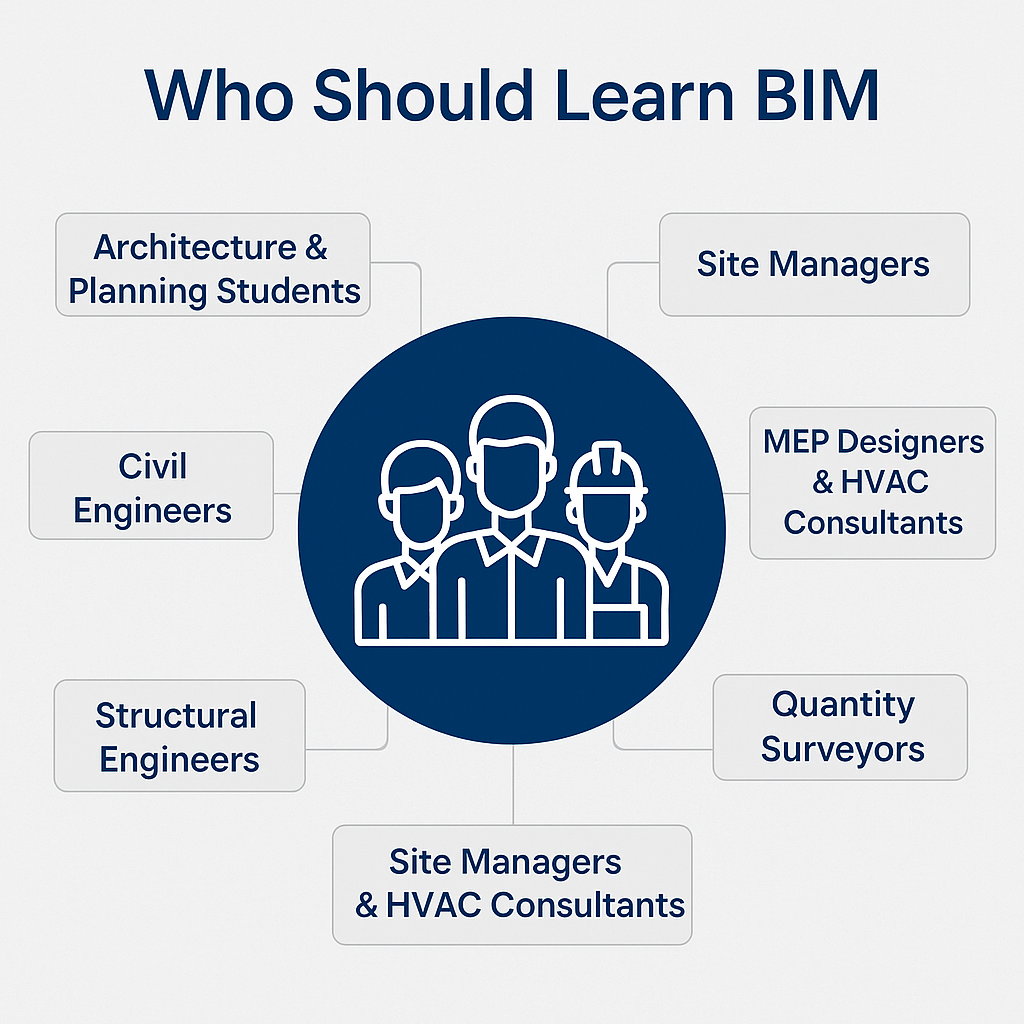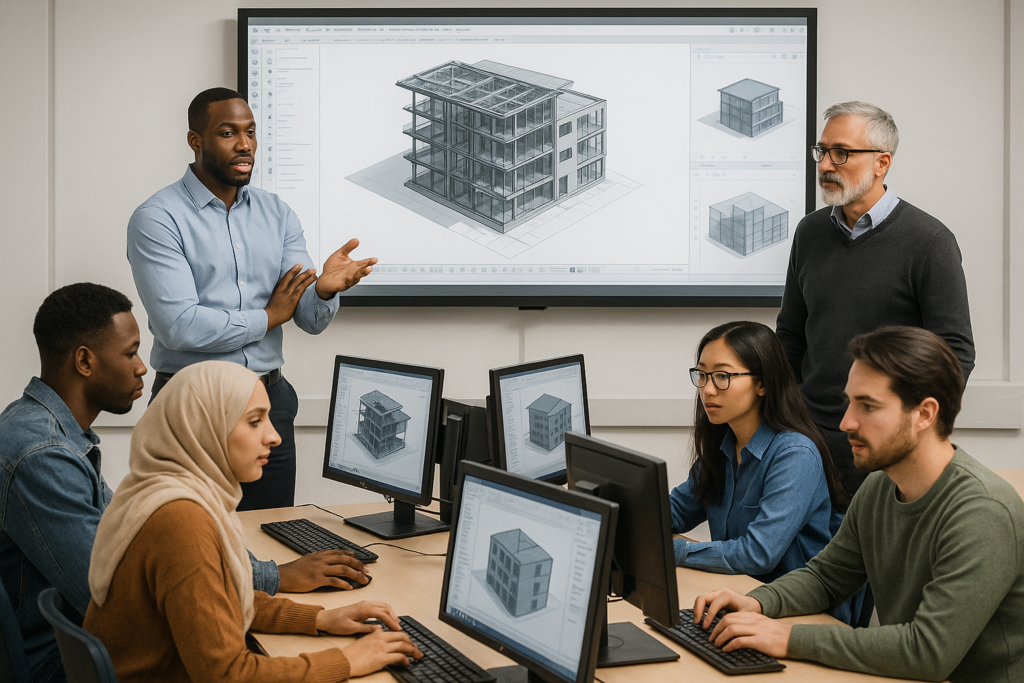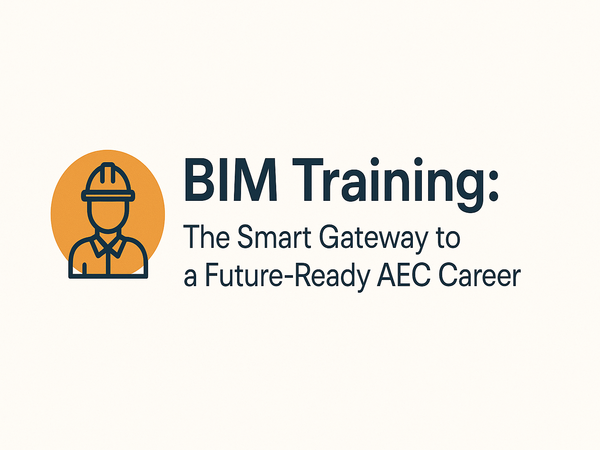The Architecture, Engineering, and Construction (AEC) industry is undergoing a digital revolution, and Building Information Modeling (BIM) lies at the heart of this transformation. From smart cities to sustainable high-rises, BIM has become the global standard for how infrastructure is planned, designed, constructed, and maintained. But with rapid adoption comes the demand for skilled professionals making BIM training more crucial than ever.
Whether you’re an aspiring architect, a civil engineer, or a working professional in the AEC domain, enrolling in a quality BIM training program can be your launchpad to lucrative career opportunities both in India and abroad.
What is BIM and Why Does It Matter?
BIM is not just a software; it’s a collaborative digital process that enables multi-disciplinary teams to create and manage building and infrastructure data across the project lifecycle. It integrates 3D modeling with time (4D), cost (5D), and operational information (6D, 7D), offering a holistic and highly efficient approach to project delivery.
Benefits of BIM in Construction:
- Improved coordination among architects, engineers, and contractors
- Reduced errors and rework through clash detection and real-time updates
- Enhanced visualization with detailed 3D models
- Streamlined project timelines through 4D scheduling
- Accurate quantity takeoffs and cost estimation using 5D BIM
- Informed facility management post-construction
With such advantages, it’s no surprise that BIM is now mandated in several government projects and widely adopted by private firms, making BIM expertise a highly valued skill in the job market.
Who Should Learn BIM?
BIM is an interdisciplinary skill applicable to various roles in the AEC industry. If you’re in any of the following professions, BIM training can give your career a competitive edge:
- Architecture and Planning Students
- Civil Engineers and Site Managers
- MEP Designers and HVAC Consultants
- Structural Engineers
- Quantity Surveyors
- Construction Managers
- Project Coordinators
- Facility Managers
In fact, many students are now including BIM proficiency in their final-year portfolios and resumes to increase job placement potential right after graduation.

What Does a Good BIM Training Program Offer?
A robust BIM training program goes beyond teaching software. It imparts a systematic understanding of BIM processes, international standards, and real-world project exposure. Here are the essentials:
Core Learning Modules:
- Fundamentals of BIM and ISO Standards
Learn about BIM Level 0 to 3, ISO 19650, and BEP (BIM Execution Plan). - Revit Architecture, Structure & MEP
Comprehensive training on Autodesk Revit tools tailored for multiple disciplines. - Clash Detection with Navisworks
Identify and resolve design conflicts in a collaborative environment. - 5D BIM for Quantity Estimation and Cost Planning
Learn to integrate BOQ (Bill of Quantities) and real-time cost updates. - Construction Simulation (4D BIM)
Visualize construction phases using time-based animations. - Introduction to Common Data Environments (CDE)
Get hands-on with BIM 360, Trimble Connect, or other cloud-based platforms. - LOD (Level of Development) and Industry Workflows
Understand how to deliver content aligned with LOD 100 to 500. - Live Capstone Project
Work on simulated real-life projects that mirror actual industry challenges.
Institutes offering project-based learning, mentorship from experienced professionals, and practical exposure to global workflows stand out as excellent training providers.
How to Choose the Right BIM Training Institute?
Choosing the right training provider can make or break your BIM learning experience. While many institutions claim to offer BIM courses, only a few provide holistic, industry-aligned programs.
Look for the following traits:
- ISO or Autodesk-authorized training center status
- Project-based curriculum with live assignments
- Expert trainers with real-world BIM experience
- Flexible learning modes (online, hybrid, classroom)
- Job placement or internship support
- Positive student reviews and portfolio showcases
Some India-based institutes have gained a strong reputation for offering high-impact BIM training through a blend of technical depth, global standards, and placement-oriented programs. These centers are often referred to in forums and student groups for their hands-on project delivery, faculty quality, and real-time exposure to construction workflows.
One such institute has trained thousands of professionals, including working engineers and recent graduates, and has helped them get placed in top firms like AECOM, L&T, Tata Projects, and various international design consultancies.

Online vs Offline BIM Training – What’s Better?
Both online and offline BIM training formats offer unique benefits depending on your schedule, location, and learning preference.
Online BIM Training:
- Learn from anywhere
- Ideal for working professionals
- Flexible batch timings
- Access to recorded sessions
Offline BIM Training:
- In-person mentorship
- Hands-on software labs
- Peer interaction and networking
- Faster doubt resolution
Hybrid formats are increasingly popular combining the flexibility of online modules with the effectiveness of in-person project guidance and assessments.
Career Opportunities After BIM Training:-
Once you’ve mastered BIM, your career options multiply significantly. BIM skills are in demand across infrastructure projects, high-rise developments, metro and rail systems, airports, industrial plants, and more.
Common Job Roles:
| Role | Average Salary (India) | Skills Required |
|---|---|---|
| BIM Modeler | ₹3–6 LPA | Revit, Navisworks |
| BIM Coordinator | ₹5–10 LPA | Clash detection, BEP |
| BIM Engineer | ₹6–12 LPA | Multi-discipline modeling |
| Quantity Surveyor with BIM | ₹5–9 LPA | 5D BIM, estimation |
| Digital Construction Analyst | ₹7–12 LPA | 4D/5D, CDE tools |
Several government tenders now list BIM capability as a requirement. Private organizations involved in design-build (DB) and engineering-procurement-construction (EPC) models are hiring BIM professionals to lead digital project delivery.
Testimonials from BIM Professionals:-
“After completing a structured BIM course, I transitioned from CAD drafting to leading the BIM coordination team in a metro rail project.”
— Akshay M., Structural Engineer
“The BIM course I took gave me not only software knowledge but also helped me understand global AEC workflows. I got placed within 3 months!”
— Sneha R., Architect
Such transformations highlight the power of quality BIM training. Institutes that simulate real-life project challenges prepare students to handle industry tasks from day one.
How Long Does It Take to Learn BIM?
- Basic Training: 30–45 days (ideal for freshers)
- Intermediate Level: 2–3 months (includes projects)
- Advanced Certification: 4–6 months (for job readiness, includes capstone)
Your pace may vary depending on your background. Architectural and civil engineering students typically pick up modeling tools faster, while MEP engineers benefit from specialized discipline-wise modules.
The Future of BIM in India and Beyond
With the Indian government pushing for digital project delivery through BIM in initiatives like Smart Cities, AMRUT, and PM Gati Shakti, BIM will soon be the default across large-scale infrastructure. Globally, BIM adoption is already mature in countries like the UK, UAE, and Singapore making international career paths more accessible to certified BIM professionals from India.
Moreover, as BIM merges with newer technologies like IoT, Digital Twins, AI, and Augmented Reality, future job roles will evolve toward BIM-integrated smart facility management, sustainability modeling, and automated quantity extraction.

Final Thoughts
BIM is not just another skill it’s the language of tomorrow’s construction industry. Investing in a high-quality, project-driven BIM training program is the smartest move you can make if you’re serious about your AEC career.
By equipping yourself with BIM proficiency, you’re not just learning a software you’re learning how to communicate better, collaborate smarter, and build faster.
If you’re seeking a program that offers real industry integration, practical exposure, and placement support, consider looking into reputed Indian institutes that specialize in such offerings. A few have already built a solid reputation through consistent student outcomes and industry recognition.
FAQs:-
Q1: Is BIM only for architects?
No. BIM benefits professionals across disciplines civil, MEP, structural, planning, and facility management.
Q2: What are the prerequisites for learning BIM?
A background in civil, architecture, or engineering helps, but many institutes offer beginner-friendly training.
Q3: Can I learn BIM software like Revit on my own?
You can learn the basics, but structured training ensures you understand coordination, standards, and workflows key for professional growth.
Q4: How much does BIM training cost in India?
It varies, but a comprehensive program can range from ₹10,000 to ₹45,000 depending on duration, format, and depth.
Q5: Do BIM certifications help in job applications?
Absolutely. Certifications from recognized institutions boost your resume and increase chances of placement.
Read More On:-
For more information about engineering, architecture, and the building & construction sector, go through the posts related to the same topic on the Specuwin Blog Page.
Find out more accurately what we are going to take off in the course of applying leading new technologies and urban design at Specuwin.
